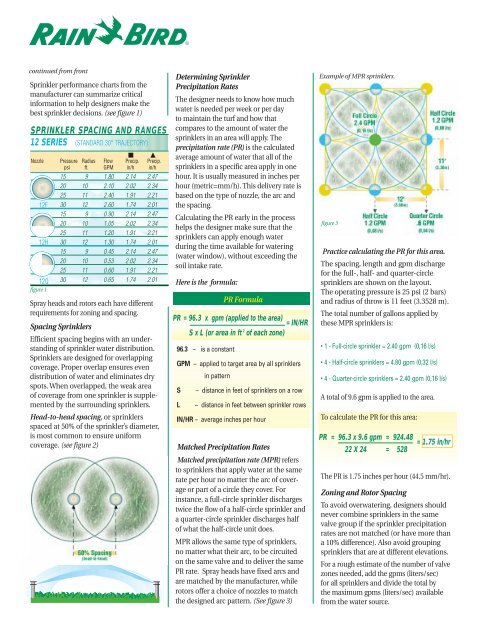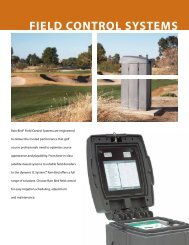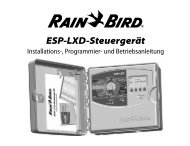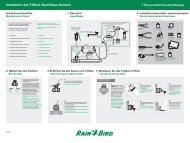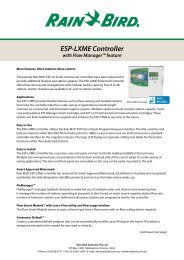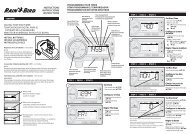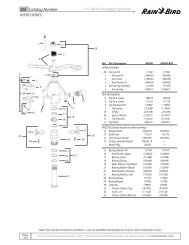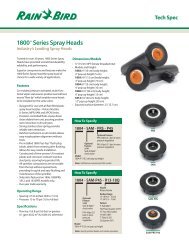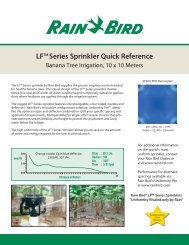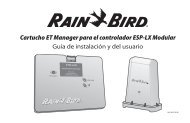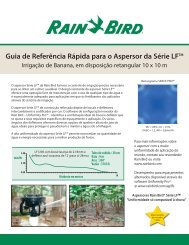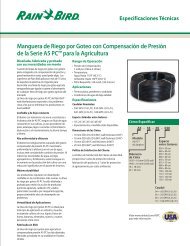Sprinkler Spacing and Design - Rain Bird
Sprinkler Spacing and Design - Rain Bird
Sprinkler Spacing and Design - Rain Bird
Create successful ePaper yourself
Turn your PDF publications into a flip-book with our unique Google optimized e-Paper software.
continued from front<br />
<strong>Sprinkler</strong> performance charts from the<br />
manufacturer can summarize critical<br />
information to help designers make the<br />
best sprinkler decisions. (see figure 1)<br />
SPRINKLER SPACING AND RANGES<br />
12 SERIES (STANDARD 30° TRAJECTORY)<br />
Nozzle Pressure Radius Flow Precip. Precip.<br />
psi ft. GPM in/h in/h<br />
15 9 1.80 2.14 2.47<br />
20 10 2.10 2.02 2.34<br />
25 11 2.40 1.91 2.21<br />
12F 30 12 2.60 1.74 2.01<br />
15 9 0.90 2.14 2.47<br />
20 10 1.05 2.02 2.34<br />
25 11 1.20 1.91 2.21<br />
12H 30 12 1.30 1.74 2.01<br />
15 9 0.45 2.14 2.47<br />
20 10 0.53 2.02 2.34<br />
25 11 0.60 1.91 2.21<br />
12Q<br />
figure 1<br />
30 12 0.65 1.74 2.01<br />
Spray heads <strong>and</strong> rotors each have different<br />
requirements for zoning <strong>and</strong> spacing.<br />
<strong>Spacing</strong> <strong>Sprinkler</strong>s<br />
Efficient spacing begins with an underst<strong>and</strong>ing<br />
of sprinkler water distribution.<br />
<strong>Sprinkler</strong>s are designed for overlapping<br />
coverage. Proper overlap ensures even<br />
distribution of water <strong>and</strong> eliminates dry<br />
spots. When overlapped, the weak area<br />
of coverage from one sprinkler is supplemented<br />
by the surrounding sprinklers.<br />
Head-to-head spacing, or sprinklers<br />
spaced at 50% of the sprinkler’s diameter,<br />
is most common to ensure uniform<br />
coverage. (see figure 2)<br />
Determining <strong>Sprinkler</strong><br />
Precipitation Rates<br />
The designer needs to know how much<br />
water is needed per week or per day<br />
to maintain the turf <strong>and</strong> how that<br />
compares to the amount of water the<br />
sprinklers in an area will apply. The<br />
precipitation rate (PR) is the calculated<br />
average amount of water that all of the<br />
sprinklers in a specific area apply in one<br />
hour. It is usually measured in inches per<br />
hour (metric=mm/h). This delivery rate is<br />
based on the type of nozzle, the arc <strong>and</strong><br />
the spacing.<br />
Calculating the PR early in the process<br />
helps the designer make sure that the<br />
sprinklers can apply enough water<br />
during the time available for watering<br />
(water window), without exceeding the<br />
soil intake rate.<br />
Here is the formula:<br />
PR Formula<br />
PR = 96.3 x gpm (applied to the area) = IN/HR<br />
S x L (or area in ft 2 of each zone)<br />
96.3 – is a constant<br />
GPM – applied to target area by all sprinklers<br />
in pattern<br />
S – distance in feet of sprinklers on a row<br />
L – distance in feet between sprinkler rows<br />
IN/HR – average inches per hour<br />
Matched Precipitation Rates<br />
Matched precipitation rate (MPR) refers<br />
to sprinklers that apply water at the same<br />
rate per hour no matter the arc of coverage<br />
or part of a circle they cover. For<br />
instance, a full-circle sprinkler discharges<br />
twice the flow of a half-circle sprinkler <strong>and</strong><br />
a quarter-circle sprinkler discharges half<br />
of what the half-circle unit does.<br />
MPR allows the same type of sprinklers,<br />
no matter what their arc, to be circuited<br />
on the same valve <strong>and</strong> to deliver the same<br />
PR rate. Spray heads have fixed arcs <strong>and</strong><br />
are matched by the manufacturer, while<br />
rotors offer a choice of nozzles to match<br />
the designed arc pattern. (See figure 3)<br />
Example of MPR sprinklers.<br />
figure 3<br />
Practice calculating the PR for this area.<br />
The spacing, length <strong>and</strong> gpm discharge<br />
for the full-, half- <strong>and</strong> quarter-circle<br />
sprinklers are shown on the layout.<br />
The operating pressure is 25 psi (2 bars)<br />
<strong>and</strong> radius of throw is 11 feet (3.3528 m).<br />
The total number of gallons applied by<br />
these MPR sprinklers is:<br />
• 1 - Full-circle sprinkler = 2.40 gpm (0,16 l/s)<br />
• 4 - Half-circle sprinklers = 4.80 gpm (0,32 l/s)<br />
• 4 - Quarter-circle sprinklers = 2.40 gpm (0,16 l/s)<br />
A total of 9.6 gpm is applied to the area.<br />
To calculate the PR for this area:<br />
PR = 96.3 x 9.6 gpm = 924.48 = 1.75 in/hr<br />
22 X 24 = 528<br />
The PR is 1.75 inches per hour (44.5 mm/hr).<br />
Zoning <strong>and</strong> Rotor <strong>Spacing</strong><br />
To avoid overwatering, designers should<br />
never combine sprinklers in the same<br />
valve group if the sprinkler precipitation<br />
rates are not matched (or have more than<br />
a 10% difference). Also avoid grouping<br />
sprinklers that are at different elevations.<br />
For a rough estimate of the number of valve<br />
zones needed, add the gpms (liters/sec)<br />
for all sprinklers <strong>and</strong> divide the total by<br />
the maximum gpms (liters/sec) available<br />
from the water source.


